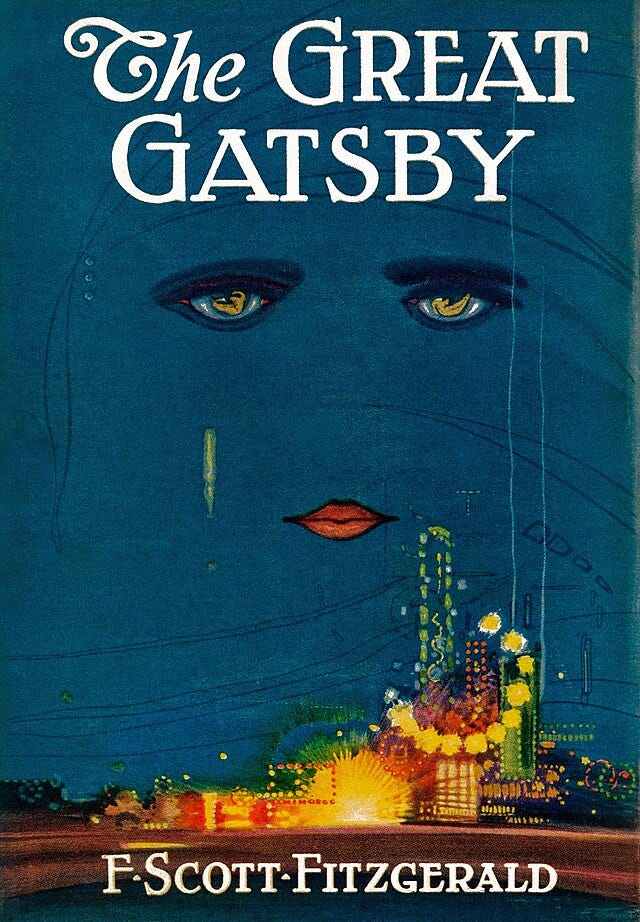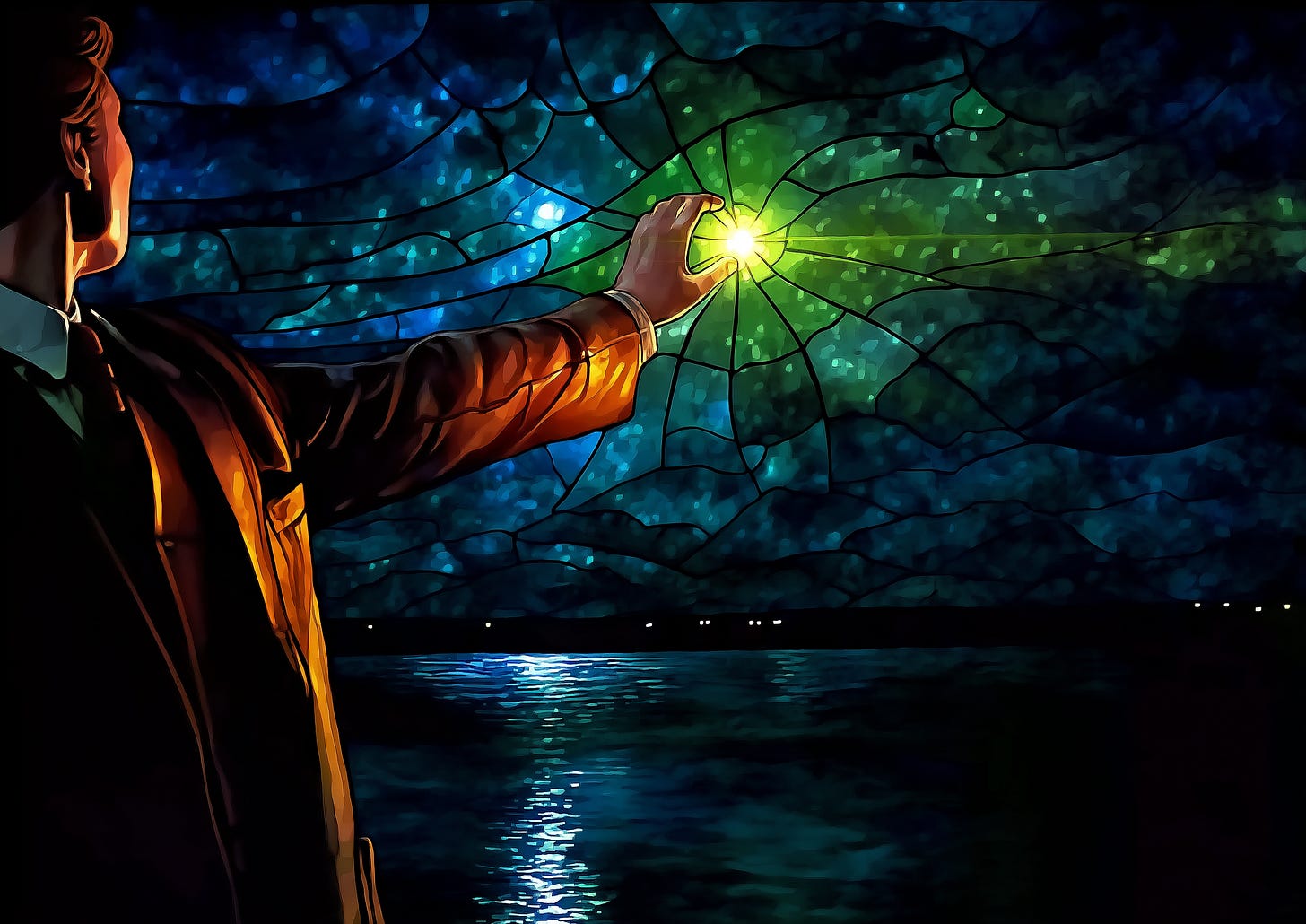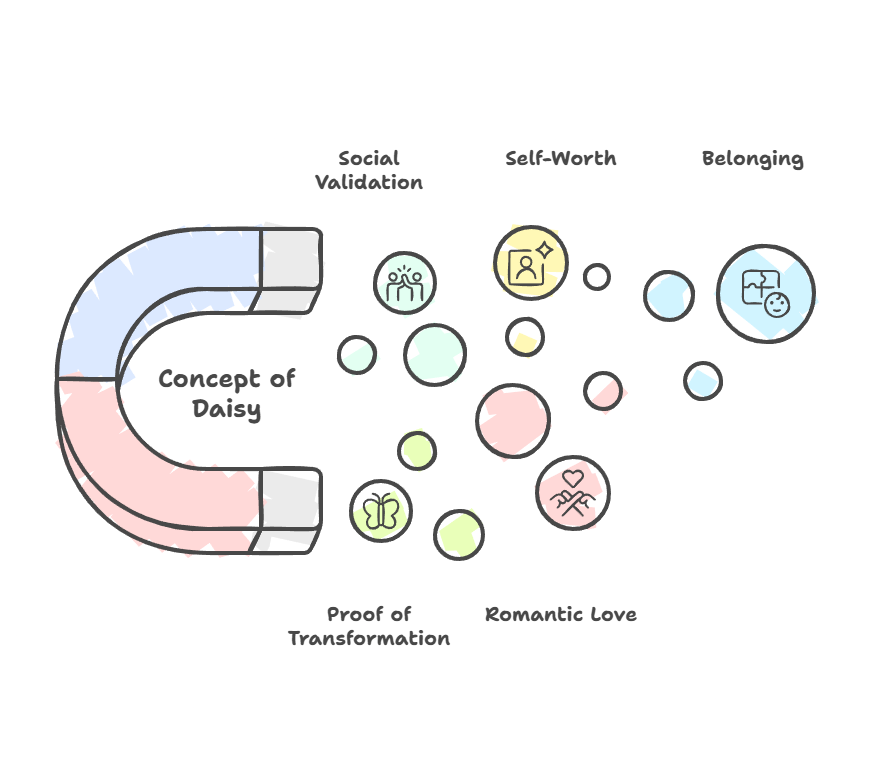The Green Light Wasn’t the Problem: Gatsby’s Fatal Misidentification
The Question That Changes Everything - Article 4
This is the fourth article in our series where we analyze great stories through the lens of my Values-Needs Theory - examining how understanding the question “What need are they trying to meet?” reveals hidden patterns in literature’s most enduring characters. If you’ve missed any, you’ll find a list of all the articles in the series at the end of this article.
In F. Scott Fitzgerald’s The Great Gatsby, there’s a green light that shines across the water from a dock—a small beacon that becomes one of the most famous symbols in American literature. It sits at the end of Daisy Buchanan’s pier, visible from Jay Gatsby’s mansion across the bay. Night after night, Gatsby stands on his dock reaching toward it, and classic interpretations tell us this light represents his yearning for Daisy, his lost love.
But is that classic interpretation actually the whole truth of it?
What if Gatsby spent five years staring at that green light, thinking he was reaching for love... when he was really reaching for proof that he was worthy of existing?
What Everyone Thinks the Green Light Means
The traditional reading is straightforward: Gatsby loves Daisy. They had a brief romance five years earlier when he was a young soldier named James Gatz. She was rich, he was poor. She married the wealthy Tom Buchanan while Gatsby was overseas. Now Gatsby has made himself rich through mysterious means and bought a mansion across from her house, throwing lavish parties in hopes she’ll wander into one of them.
The green light at the end of her dock represents his hope... his dream... his love for her that refuses to die.
Except let’s look closer at what Gatsby actually did to “win” Daisy back.
James Gatz was a poor farm boy from North Dakota. At seventeen, he met Dan Cody, a wealthy yacht owner, and completely reinvented himself. He became Jay Gatsby - a man who claims to be an Oxford graduate, who throws parties for hundreds of people he doesn’t know, who drives a massive yellow Rolls-Royce and wears pink suits.
Everything about Gatsby is performance. His house is “a factual imitation of some Hôtel de Ville in Normandy.” His library is filled with real books, but their pages are uncut - they’re props. Even his speech patterns are carefully constructed - he says “old sport” in a way that sounds almost rehearsed.
Gatsby built his entire life around Daisy Buchanan. The mansion across the bay. The lavish parties hoping she’d wander in. The complete reinvention from James Gatz, farm boy, to Jay Gatsby, mysterious millionaire. All of it aimed at one goal: winning back the woman he loved five years ago.
But what if Daisy was never what he actually needed?
The Real Need Hidden Underneath
What’s fascinating about Gatsby is that if he’d just asked himself one question - “What need am I trying to meet?” - and then kept asking it, kept digging deeper, he might have discovered something that could have saved him.
Let’s do the investigation Gatsby never did. Let’s keep asking “What need am I trying to meet?” until we can’t go any deeper.
First layer: “I need Daisy.”
Okay, but what need are you trying to meet by getting Daisy?
Second layer: “I need to be accepted by the upper class. I need to belong to old money society.”
But what need are you trying to meet with that acceptance? Why does belonging to the upper class matter?
Third layer: “I need to prove I’m somebody. I need people to acknowledge that I matter, that I’m legitimate, that Jay Gatsby is real.”
And what need are you trying to meet by proving you’re somebody? What happens if you can prove it?
Fourth layer: Here’s where we hit bedrock - the actual fundamental needs:
The need for acknowledgment - to be seen as existing, as mattering
The need for belonging and connection - to not be isolated or rejected
The need for self-acceptance - to live with yourself, to maintain internal consistency
The need for dignity and worth - basic human worth acknowledged
These are the actual needs. You can’t dig deeper than these. They’re not strategies for meeting other needs - they’re the needs themselves. They’re tied to survival and the pursuit of life itself. When they’re chronically unmet, they create dysfunction and suffering.
But look at what Gatsby did. He stopped at the first or second layer. He thought Daisy was the need. Or maybe he thought acceptance by the upper class was the need. He never kept asking the question until he got to the bedrock.
Here’s why that matters:
If Gatsby had realized his actual need was for acknowledgment and belonging, he could have found it. There were people who would have genuinely seen him and accepted him - Nick did. Jordan did, in her way. The hundreds of people at his parties were drawn to something real in him.
If he’d realized he needed self-acceptance and dignity, he could have worked on integrating James Gatz and Jay Gatsby into one authentic person instead of trying to kill one to make the other real.
But because he misidentified the need as “Daisy” or “upper class acceptance,” he aimed all his magnificent effort at targets that could never meet his actual fundamental needs. Even if Daisy had left Tom for him, even if old money society had accepted him... it wouldn’t have given him what he actually needed. Because external validation can’t create internal self-acceptance. Other people’s acknowledgment can’t substitute for your own sense of worth.
What Her Voice Actually Revealed
There’s a moment in the novel that reveals everything about Gatsby’s misidentification. Nick Carraway, our narrator, is watching Gatsby and Daisy together when Gatsby makes an observation that hits Nick like a revelation:
“Her voice is full of money.”
Nick realizes: “That was it. I’d never understood before. It was full of money - that was the inexhaustible charm that rose and fell in it, the jingle of it, the cymbals’ song of it.”
Think about what this means. When Gatsby listens to Daisy speak, he’s not hearing the woman. He’s hearing wealth, status, social position - everything he believes will prove James Gatz successfully “died” and Jay Gatsby is real.
But notice what Gatsby is doing here. He’s expecting one person - Daisy - to simultaneously provide:
Romantic love and connection
Social acceptance and status
Validation of his transformed identity
Proof that James Gatz successfully “died”
Evidence that Jay Gatsby is real and worthy
A sense of competence and achievement
This is magical thinking. No person can do all that. But when you mistake a strategy (getting Daisy) for the need itself (acknowledgment, belonging, self-acceptance), you don’t realize you’re asking for the impossible.
The Strategy He Confused with a Need
Here’s where it gets genuinely tragic.
Daisy isn’t a need. “Acceptance by the upper class” isn’t a need. These are strategies - strategies Gatsby hoped would meet his fundamental needs for acknowledgment, belonging, self-acceptance, and worth.
But Gatsby never distinguished between the strategy and the need. He didn’t even stop to identify what his needs actually were, let alone whether or not the strategy he was taking was going to be effective.
Think about what happens when you do that. If his actual need is acknowledgment and belonging, but he thinks the need is “Daisy” or “upper class acceptance,” then he’s locked himself into one specific strategy for meeting needs that could be met many different, and likely better ways.
The need for acknowledgment? Could be met by people who genuinely see him - which Nick did, which many others would have if Gatsby had been authentic with them.
The need for belonging? Could be met by finding his actual people - other strivers, other dreamers, people who understood transformation and ambition.
The need for self-acceptance? Could only be met by internal work - by integrating James Gatz and Jay Gatsby into one real person instead of trying to kill one to make the other legitimate.
The need for worth and dignity? These are inherent. They don’t require anyone else’s validation. But recognizing that would have meant doing the hardest work of all.
But because Gatsby thought “Daisy” was the need itself, he spent five years pursuing a strategy that could never meet his actual needs. Even if she had left Tom for him, even if old money society had accepted him... his fundamental needs still wouldn’t be met. Because you can’t meet internal needs through external strategies alone.
The Pattern We All Recognize
What makes this so powerful is that we all do versions of this. Maybe not as dramatically, maybe not with such devastating consequences, but we do it.
We fixate on specific solutions without asking what need we’re trying to meet. “If I just had that promotion...” “If this person would just love me back...” “If I could just lose the weight...” “If I could just buy that house...”
We build elaborate strategies around these specific goals, never questioning whether achieving them would actually meet our underlying need. We confuse the strategy with the need itself.
I see it everywhere. The person who thinks they need a specific romantic partner when what they really need is authentic human connection. The entrepreneur who thinks they need a billion-dollar company when what they really need is to feel self-worth. The perfectionist who thinks they need flawless performance when what they really need is safety from a toxic work environment.
Like Gatsby, we aim our entire magnificent effort at the wrong target because we never investigate our actual need.
The Questions Gatsby Never Asked
What devastates me about Gatsby is imagining the questions that could have saved him. Simple questions. Obvious questions once you know to ask them.
“Why do I want Daisy specifically? What do I think will happen if I get her? What do I believe she’ll give me that I don’t have now?”
Or even more directly: “Is this about Daisy the person, or is it about what Daisy represents?”
And the follow-up that might have changed everything: “If it’s about what she represents, is there another way to meet that need? A way that doesn’t require the impossible — repeating the past, becoming old money, erasing who I was?”
These aren’t complicated questions. But when you’re deep in the obsession, when you’ve built your entire identity around a single goal, they’re almost impossible to ask. The fixation itself prevents the investigation.

What Nick Saw That Gatsby Couldn’t
Nick Carraway, our narrator, sees something Gatsby can’t. He sees the futility. He sees that the green light — that symbol of Gatsby’s yearning — is just a light. He sees that Daisy is just a person, flawed and shallow and ultimately not worth dying for.
But here’s what I’m realizing... Nick sees this because he’s not the one with the unmet need. It’s always easier to see someone else’s misidentification than your own. When you’re not desperate for belonging, it’s obvious that marrying into old money won’t make you belong. When you’re not seeking validation of worth, it’s clear that another person’s choice can’t give you that.
This is why the question “What need are they trying to meet?” is so powerful when applied to others — and so difficult when applied to ourselves. Our own unmet needs create blind spots exactly where we most need clarity.
Learning from Gatsby’s Misidentification
So what do we do with this? How do we avoid our own Gatsby-style tragedy?
First, we have to be willing to investigate our fixations. When we find ourselves obsessed with a specific outcome, a specific person, a specific achievement, we need to pause and ask: “Is this the need itself, or is this a strategy I’m hoping will meet a deeper need?”
Second, we have to distinguish between people and what they represent. Gatsby couldn’t see Daisy as separate from what she symbolized. She was wealth, acceptance, proof of worth all wrapped in one person. But people can’t be symbols. They’re just people.
Third, we have to be willing to be wrong about what we need, and willing to dig deeper. This might be the hardest part. Gatsby built his entire identity around needing Daisy. To question that would have meant questioning everything. But that’s exactly what might have saved him.
When you find yourself obsessed with a specific outcome, a specific person, a specific achievement, don’t just ask “What need am I trying to meet?” once. Ask it a second time:
What need am I trying to meet?
And what need am I trying to meet with that?
You think “I need the promotion” when the actual need is acknowledgment or competence. You think “I need this relationship” when the actual need is connection or self-acceptance. You think “I need social media success” when the actual need is belonging or to be seen.
Here’s what changes when you identify the actual fundamental need: you realize there are multiple strategies for meeting it. You’re not locked into one specific outcome that may be impossible or insufficient.
Need acknowledgment? That can come from many sources, not just one person or institution.
Need connection? You can find your actual people instead of trying to force your way into places you don’t fit.
Need self-acceptance? That’s internal work, not something anyone else can give you.
Need competence? Build genuine capability rather than chasing symbols of capability.
The Question That Changes Everything
Misidentifying our needs might be more dangerous than not identifying them at all. At least when we know we don’t know what we need, we stay open to discovery. But when we’ve misidentified the need — when we’ve locked onto the wrong answer — we can waste our entire lives chasing something that can’t actually give us what we’re seeking.
Because unlike Gatsby, we still have time to ask. We still have time to investigate. We still have time to aim our magnificent efforts at the right target.
The green light is still blinking across the bay. But maybe, just maybe, we can realize it’s just a light. And what we really need isn’t on the other side of the water at all.
It’s been here all along, waiting for us to ask the right question.
I’m building something that matters: a framework for understanding why good people do things that conflict with their values. If you find value in this work, I’d be honored to have you subscribe.
Each week, I share insights from systematic research into how values and needs shape human behavior - from tragic heroes to everyday decisions. Your subscription helps me know this resonates and keeps the research going.
Next: “The Psychology of Breaking Bad: How Walter White’s Ego Built an Empire” - exploring how misidentified needs can corrupt our values over time, and how to recognize when you’re becoming someone you never intended to be.
What fixation in your life might be a misidentified need? What are you pursuing with Gatsby-like intensity that might not be what you actually need at all? I’d love to hear about your own discoveries in the comments.
All articles in the One Question Series:
1 - The One Question That Explains Every Tragic Hero
2 - Why Jean Valjean’s Bread Theft Explains Human Behavior
3 - Why Anna Karenina Had to Die (And How She Could Have Lived)
4 - The Green Light Wasn’t the Problem: Gatsby’s Fatal Misidentification
5 - The Psychology of Breaking Bad: How Walter White’s Ego Built an Empire



Didn't expext this take on Gatsby. It's like refactoring a legacy codebase and realyzing the original devs were actually tryna solve a deeper, unstated problem. Very insightful.